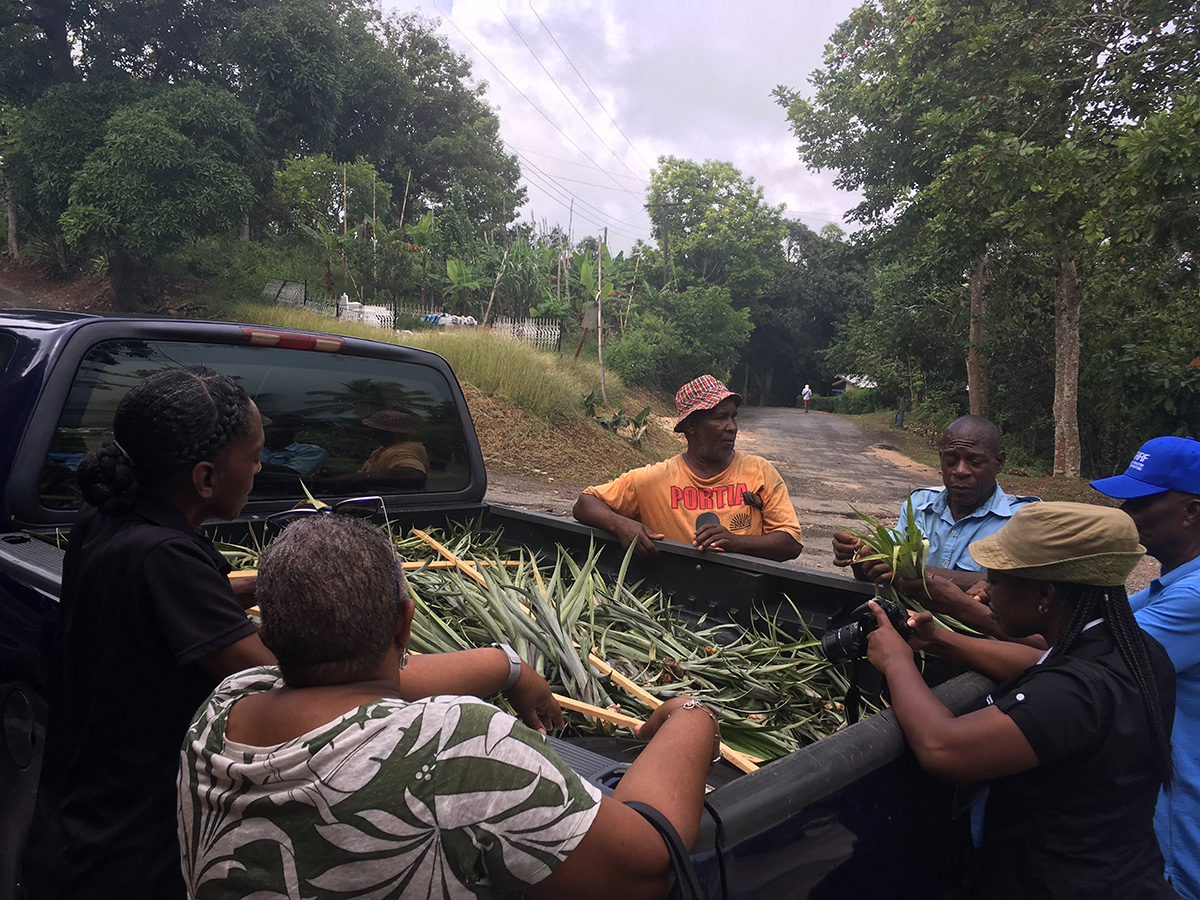Clarendon Farmers Diversifying Crop Production To Be More Climate Resilient
Clarendon, Jamaica. August 20, 2019 – Over 300 farmers from nine communities in Clarendon have increased their awareness of climate change and its effects on agriculture. Many are now diversifying their crop production to ensure greater responsiveness to climate impacts and disaster risk.

order to be more climate resilient. The farmers (on the right) share their experiences with
planting pineapple with Agricultural Specialist, Ruth Simpson (First left) and Cheryl
Dixon from the Caribbean Development Bank.
This is due to the Building Resilience and Adaptation to Climate Change while Reducing Disaster Risk in Peckham, Clarendon and Surrounding Communities” Project which is funded by the Caribbean Development Bank through the Community Disaster Risk Reduction Fund (CDRRF).
“The project aims to build the farmers resilience to the various climate impacts that affect their livelihoods – so that they can transform and adapt using new agricultural practices,” said the Project’s Manager, Faradaine Forbes-Edwards.).
The project, which is being implemented by the Environmental Health Foundation (EHF) is working with the farmers to increase their climate and disaster resilience. The farmers are from Peckham, Tweedside, Sanguinetti, Grantham, Johns Hall, Morgan’s Forest, Silent Hill, Top Alston and Frankfield, communities targeted under the EHF Project.
“We want to ensure that their levels of losses are reduced so when we get long droughts or hurricanes they can cope better than they are coping now,” said Forbes-Edwards.
She added that part of that preparation was getting the farmers to use new techniques [climate smart agricultural practices] and advanced technologies to enhance their resilience to climate change impacts. In a bid to do this, the project has had 49 training sessions addressing various agricultural best practices such as post-harvest and marketing strategies, small-scale poultry management, land husbandry, and farm business management.
“The EHF project introduced the Up-lifter (sweet potato) to the target communities. “Before the project they usually planted the Quarter million variety. The Uplifter sweet potato spreads a lot and protects the soil – within 10 weeks of planting it covers all the soil. The tubers are nice and hard and it is the export friendly variety, smooth on the outside and yellow inside,” explained Ruth Simpson, Agricultural Specialist with the Project.
The Up-lifter sweet potato does not take a lot of water to grow and is regarded as a more climate resilient crop. The farmers however have had to contend with pests such as the sweet potato weevil.
“The sweet potato weevil is devastating so we set up a pheromone trap for them. It has worked well here. One trap will work for one acre and lasts for 3 and a half months to 4 months,” said Simpson.
The community, which normally plants ginger, yam, banana, citrus among other crops, has also started using pineapples. According to Simpson, farmers in Maroon Town came up with the Bullhead pineapple – a mix between the Ripley and the Cowboy varieties – which is now being used in the community.
“It gives more suckers and it uses less water. It produces way more suckers than other pines. The average size is about 4-5 pounds. Pineapple is a drought resilient crop and if you plant it right – it’s an excellent soil erosion control measure,” she explained.
The pineapple is also used as a live barrier to help the farmers manage soil erosion in the communities.
“We also established the MD2 pineapple variety to be used as live barriers. It is an emerging variety here as well as the bullhead. The take-up by the farmers is excellent. We did the demo plot initially and have now established 40 replication plots with the farmers. They are also sharing it with their colleagues so it is spreading in the communities,” said Forbes-Edwards, while explaining that the same obtained for the sweet potato varieties.
“We had about 30 replication plots in the communities and these have doubled. The farmers are giving 2-3 additional farmers slips from their sweet potatoes so it is growing rapidly,” she said.
The project, which runs until December 2019, has also re-established in some cases and strengthened in others nine farmers groups in the target communities. The Farmers Groups are responsible for helping to sustain the climate smart agricultural practices as well as build the farmers capacities to manage their farms.
“The project has been a welcome change to the community. Our yields have increased after the soil tests and the training to help us with how to manage the soil. We are doing things differently and things are looking up,” said one farmer who is a beneficiary of the project.
Download The Jamaican Blogs™ App for your Android device: HERE
Remember to share this article on Facebook and other Social Media Platforms. To submit your own articles or to advertise with us please send us an EMAIL at: [email protected]

